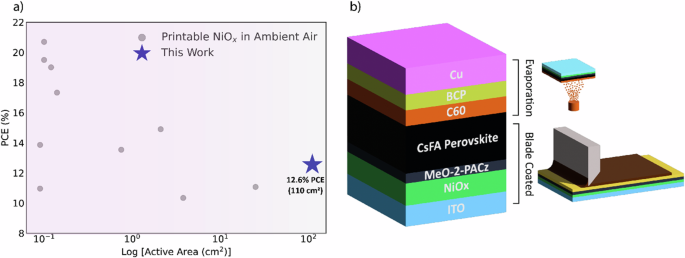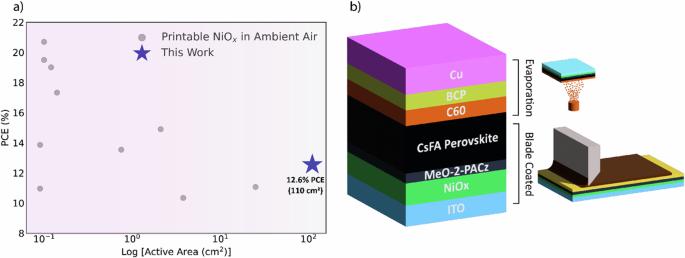Stable and sustainable perovskite solar modules by optimizing blade coating nickel oxide deposition over 15 × 15 cm2 area
IF 7.5
Q1 MATERIALS SCIENCE, MULTIDISCIPLINARY
引用次数: 0
Abstract
Perovskite solar cells have rapidly advanced, achieving over 26% power conversion efficiency on the laboratory scale. However, transitioning to large-scale production remains a challenge due to limitations in conventional fabrication methods like spin coating. Here, we introduce an optimized blade coating process for the scalable fabrication of large-area (15 cm × 15 cm) perovskite solar modules with a nickel oxide hole transport layer, performed in ambient air and utilizing a non-toxic solvent system. Self-assembled monolayers between the nickel oxide and perovskite layer improve the uniformity and morphology of the perovskite film. Perovskite solar modules with a 110 cm2 active area achieve a power conversion efficiency of 12.6%. Moreover, encapsulated modules retained 84% of their initial efficiency after 1,000 hours at 85 °C in air (ISOS-T-1). This study demonstrates progress in the large-scale production of perovskite solar cells that combine efficiency with long-term stability. Perovskite solar cells and have shown great promise on the lab scale, but work is needed to scale-up their fabrication. Here, blade coating is used to fabricate 15 cm×15 cm perovskite modules with a nickel oxide hole transport layer, achieving high power conversion efficiency and stability.


通过优化 15 × 15 平方厘米面积上的叶片涂层氧化镍沉积,实现稳定、可持续的过氧化物太阳能模块
过氧化物太阳能电池发展迅速,在实验室规模上实现了超过 26% 的功率转换效率。然而,由于旋涂等传统制造方法的局限性,过渡到大规模生产仍然是一个挑战。在此,我们介绍了一种优化的叶片涂层工艺,用于在环境空气中利用无毒溶剂系统规模化制造带有氧化镍空穴传输层的大面积(15 厘米 × 15 厘米)过氧化物太阳能模块。氧化镍和包晶层之间的自组装单层提高了包晶薄膜的均匀性和形态。活性面积为 110 平方厘米的包光体太阳能模块的功率转换效率达到了 12.6%。此外,封装模块在 85 °C 的空气中经过 1,000 小时后(ISOS-T-1),其初始效率保持了 84%。这项研究表明,在大规模生产兼具效率和长期稳定性的包晶体太阳能电池方面取得了进展。
本文章由计算机程序翻译,如有差异,请以英文原文为准。
求助全文
约1分钟内获得全文
求助全文
来源期刊

Communications Materials
MATERIALS SCIENCE, MULTIDISCIPLINARY-
CiteScore
12.10
自引率
1.30%
发文量
85
审稿时长
17 weeks
期刊介绍:
Communications Materials, a selective open access journal within Nature Portfolio, is dedicated to publishing top-tier research, reviews, and commentary across all facets of materials science. The journal showcases significant advancements in specialized research areas, encompassing both fundamental and applied studies. Serving as an open access option for materials sciences, Communications Materials applies less stringent criteria for impact and significance compared to Nature-branded journals, including Nature Communications.
 求助内容:
求助内容: 应助结果提醒方式:
应助结果提醒方式:


